The semi-circle shaped stuffed sweet has a version across many an Indian state, but Maharashtra itself boasts of several avatars of the karanji

Made during Ganesh Chaturthi and Diwali, Roopa Nabar’s gulachi karanji is a mixture of grated coconut, and a hint of suji or chana dal to lend it a grainy texture. Pic/Sayyed Sameer Abedi
In her book, From Varan Bhaat to Biryani, My Romance With Food, Mumbai resident Roopa Nabar lists a recipe for gulachi karanji. It’s different from the traditional sugar versions available in the city. She describes it as “sweetened with jaggery and deep fried to crisp perfection… a brilliant example of how you don’t need fancy ingredients to whip up sweet treats for yourself”. The crisp, flaky (and usually fried) pastry with a filling of coconut, cardamom, jaggery, poppy seeds and dried fruits, the festive sweet has many avatars across India. And perhaps around the world too.
ADVERTISEMENT
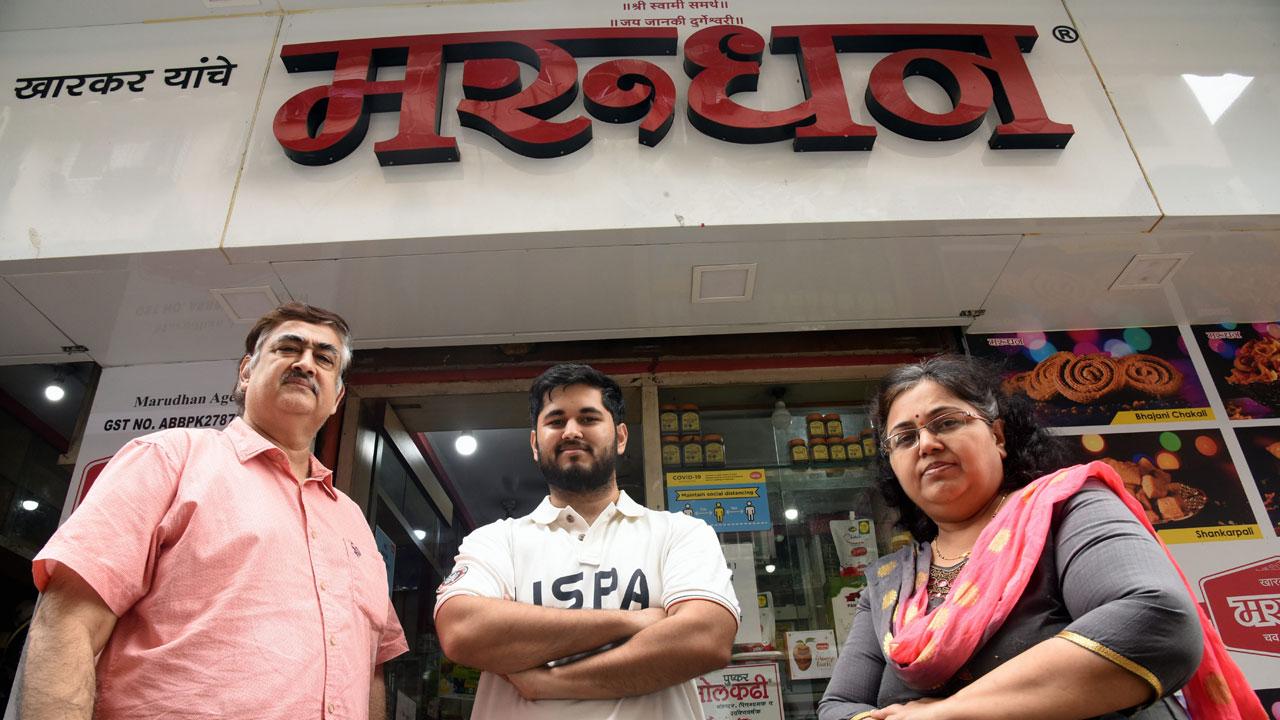
Kalwa’s Janaki Gruhodyog’s Marudhan Foods, started by Pankaj (extreme left) and Vaishali Kharkar 30 years ago now exports kanwle to the US, UK and Canada. Pic/Sameer Markande
The Spanish empanada—the sweet ones that make for great desserts and as accompaniment to afternoon coffee or tea—and the qottab, an Iranian pastry from Yazd with almond-filling and dusted with powdered sugar— are examples. Nabar brings our attention to how in Goa, the Catholics make their version of karanji, which they call nevri. Made during Christmas, it is moulded from whole wheat flour and stuffed with grated coconut, jaggery and dry fruits. “In the Konkan region, it’s called shenga—shaped like a half-moon, this one is filled with a sweet mixture of grated fresh coconut, and a hint of suji or chana dal to lend it a grainy texture. It is made during Ganpati and Diwali. The dried coconut is for prolonged shelf life. The savoury version of karanji is called ghughri in Maharashtra, and the filling is of spicy green peas, usually eaten during the naming ceremony of a child,” she explains.
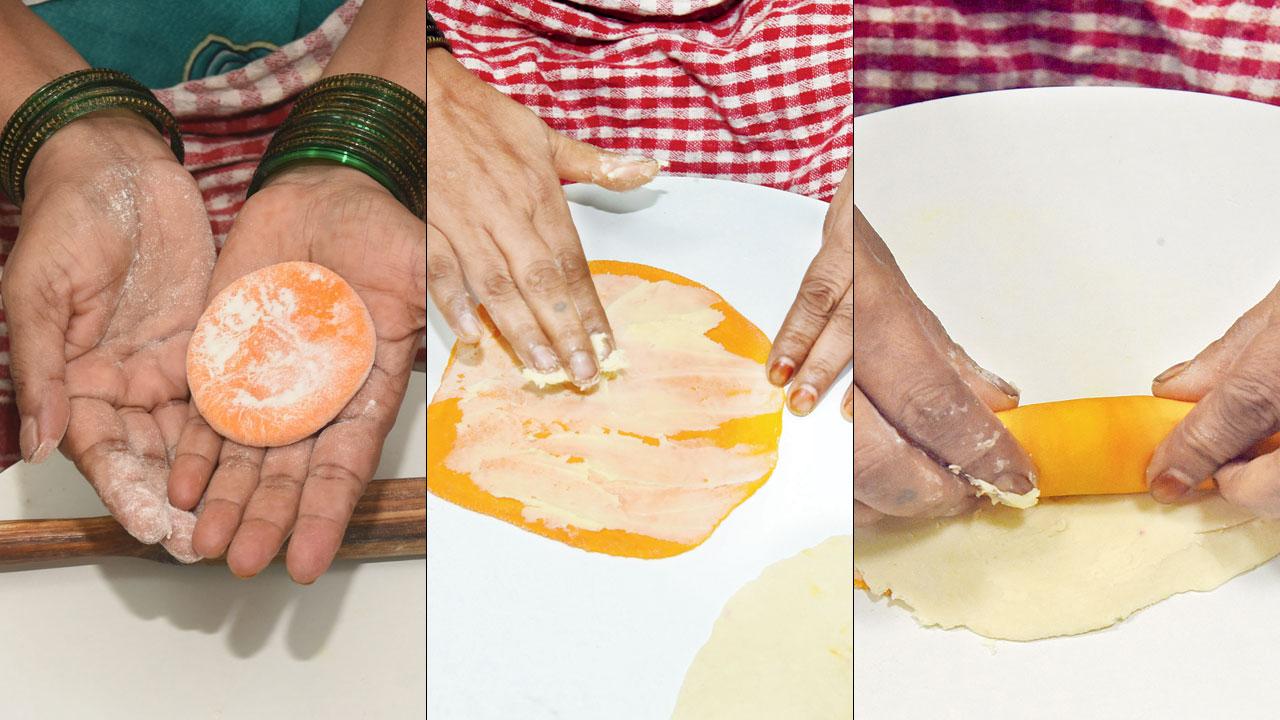
The karanji is different from its richer north Indian cousin gujiya which is made with semolina or maida and stuffed with a mixture of sweetened khoa and dried fruits, and often, fried in ghee. However, the earliest mention of gujiya dates to the 13th century, in the regions of Bundelkhand and Braj, when a jaggery-honey mixture was covered with wheat flour and sun-dried.
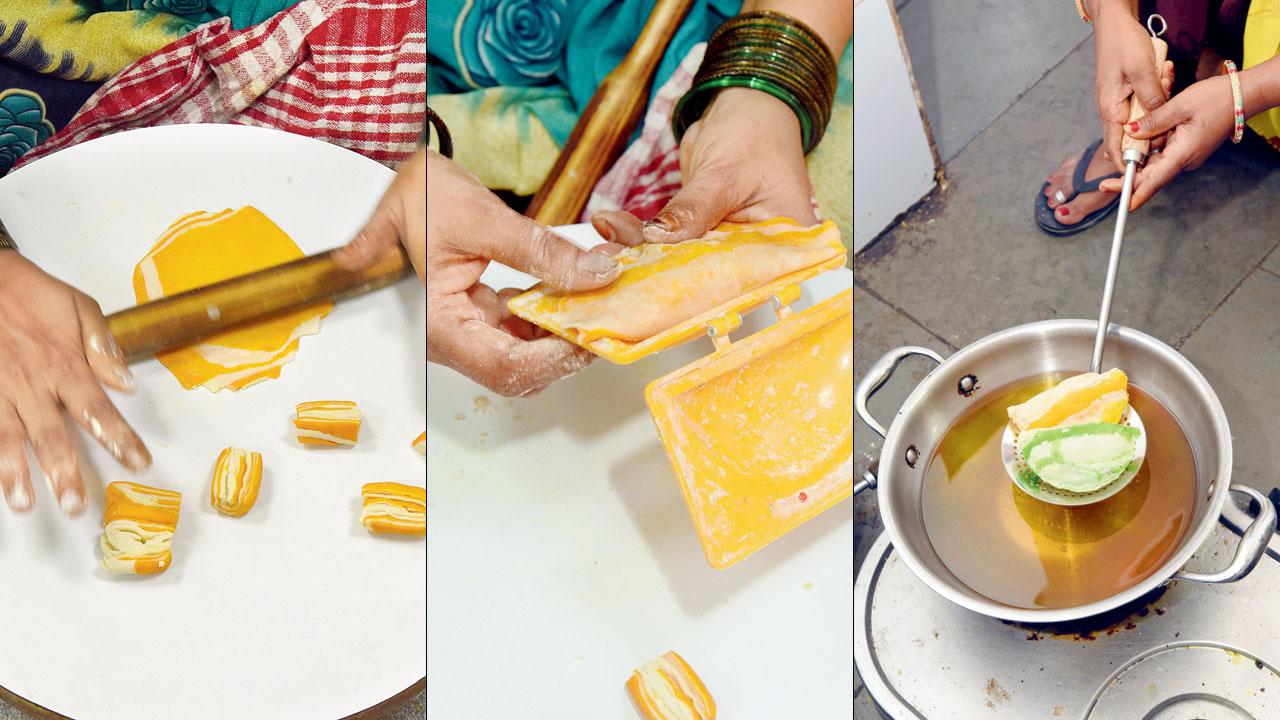
During our research, we came across an exquisite delicacy prepared during festivals in the Chandraseniya Kayastha Prabhu (CKP) community called the khajyache kanawle. Light, flaky, and colourful, making them is an art. Its layers and lightness determine the skill of the maker of a batch and it easily takes around six to eight hours to prepare a batch. Very often, even after careful preparation, the recipe fails to show layers. Kalwa’s Janaki Gruhodyog, founded by Pankaj and Vaishali Kharkar nearly three decades ago in their home kitchen, has mastered the art and retails its kanawle through the Marudhan Foods brand. This is their signature preparation. “It’s a multi-layered karanji loaded with dry coconut stuffing [pithi] and is melt-in-mouth. Colourful versions of this delicacy are also prepared during marriage ceremonies and other prosperous occasions in CKP households. It’s a lot more delicate than the regular karanji and takes utmost skill and care, not just to make but also eat,” laughs the brand’s third-generation owner Atharva Kharkar.
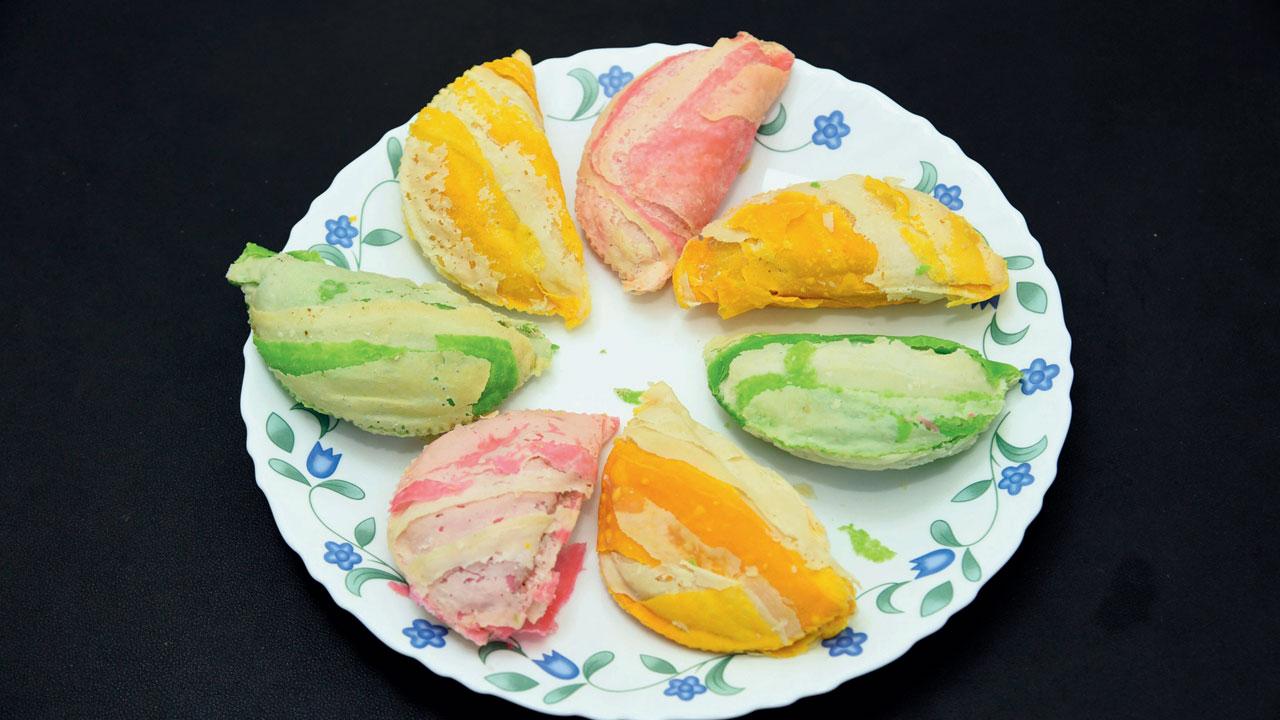 Light, flaky, and colourful, making khajyache khanawle is an art. Its layers and lightness determine the skill of the maker a batch
Light, flaky, and colourful, making khajyache khanawle is an art. Its layers and lightness determine the skill of the maker a batch
Although the Kharkars started off making these during festivals, they now hawk them all year through, training their staff to make daily batches to allow customers to walk into the store and pick up a box (Rs 50 for a piece).
Tracing its origins, author Sushama Deshpande tells mid-day, “For the CKPs, making kanawle is a tradition that’s more than a hundred years old; it’s a staple in our homes. My mother was 97 when she passed away four years ago, and it was her childhood favourite [eat]. Back in the days, every home in the Konkan had coconut trees and rice farming was common. Which means that the raw materials for it were readily available. Making the kanawle with dried coconut increases its shelf life. The wheat semolina was brought in to make it nice and flaky, a texture that can’t be achieved with rice flour.”

The Kokni Muslim version of the karanji is called chawachi puri or sheeng and is made with fresh coconut, sugar and charoli. Andheri-based home chef Mumtaz Kazi says, “This sweet dish holds a special place during wedding ceremonies when we take naashta [snacks] for the bride and bridegroom’s family—it’s the most awaited one. While it is made throughout the year, in the rainy season, crisp puris with coconut filling [called chav or chun] are heart warming. The steamed versions can be compared to the modak but the shape is the half moon.”
Gulachi karanji
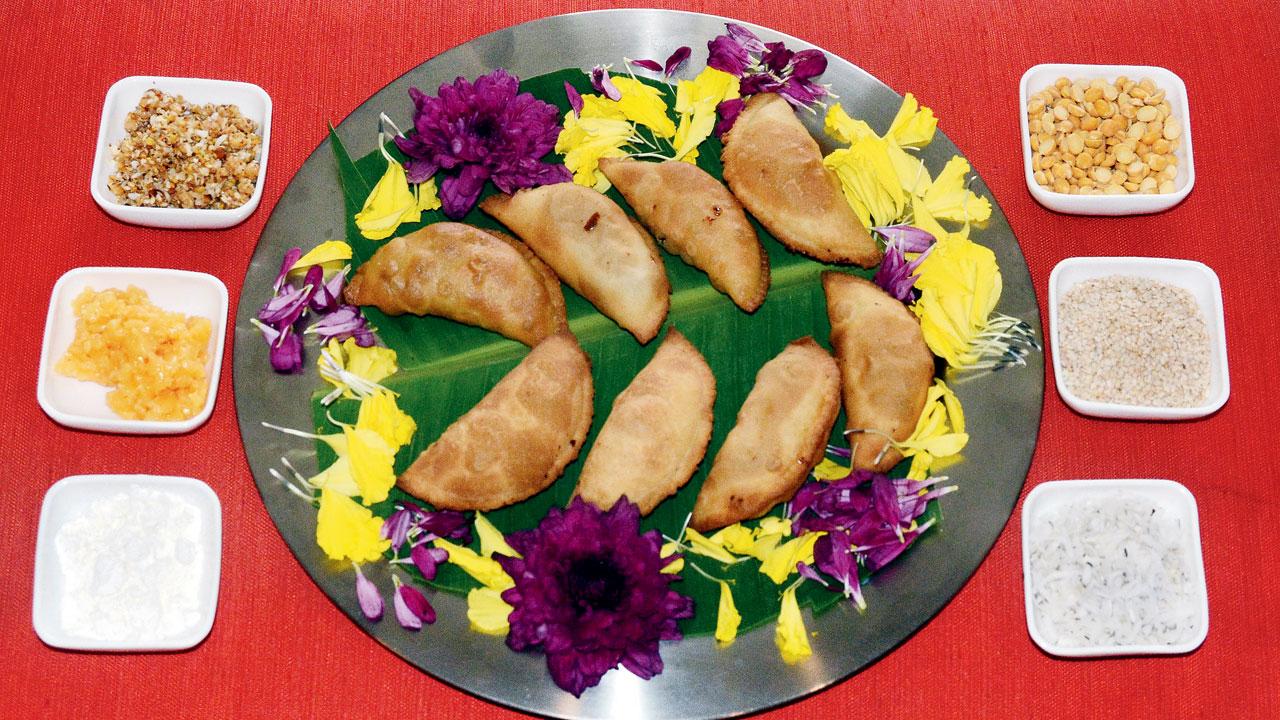
Ingredients
1/2 cup grated jaggery
1 cup grated dried coconut
1 cup refined flour or maida + for dusting
1 tbsp semolina
1 1/2 tbsp ghee
Milk as required + for sealing
1 tbsp sesame seeds
2 tbsp Bengal gram or chana dal, roasted and ground to a powder
1 tsp green cardamom powder
Oil for deep frying
Method
Combine the flour, semolina and ghee in a bowl and mix well till it resembles breadcrumbs. Add milk gradually and knead into a stiff dough. Cover and set aside. Heat a pan, add the coconut and roast for five minutes or till lightly brown. Transfer to a bowl. Dry roast the sesame seeds till well-browned in the same pan. Add to the coconut along with powdered Bengal gram and mix well. Cool the mixture to room temperature. Add the jaggery and green cardamom powder to the above mixture and mix well. Heat oil in a kadhai, divide the dough into eight equal portions and shape each portion into a small bowl. Roll out each ball into a medium disc. Place a spoonful of coconut mixture in the centre. Apply milk on the edges of half the disc; fold over and press the edges to make a crescent. Cut the extra edges with a karanji cutter, similarly, making the remaining karanjya. Deep fry on medium heat till light golden. Serve once cooled to room temperature.
Chawachi puri or sheeng
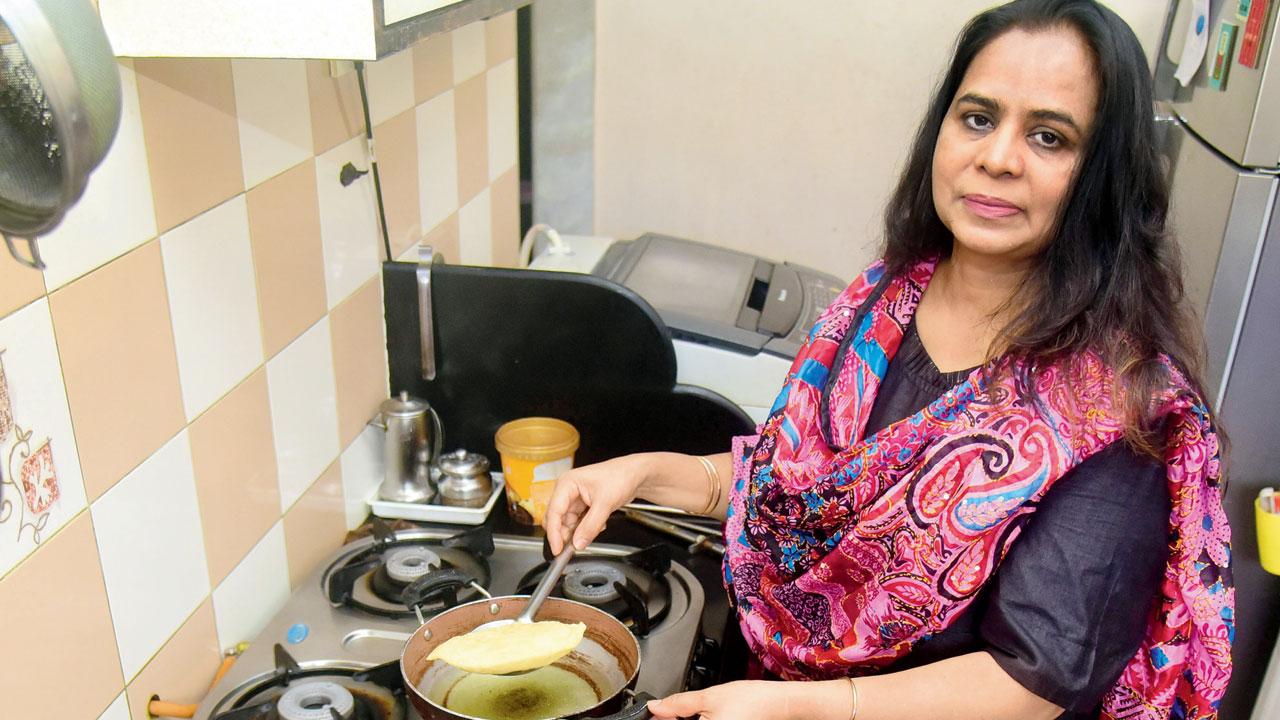
Ingredients
200 gms maida
1tsp oil
1 cup fresh coconut, scraped
¼ tsp cardamom powder
2 b ghee
A few charoli/chirongi
Oil for frying
Sugar as per taste
Method
Make a dough of maida, sprinkle oil on it and let it sit for 30 minutes. In a bowl, take scrapped coconut, add sugar as per taste, mix it and keep aside. Take a kadhai, heat ghee, and add the coconut mix, charoli and cardamom powder. Cover and cook on slow flame for 10 minutes. The mix should be moist. Roll the dough into small puris, place the coconut mixture on one side and fold like a half-moon. With a charki spoon, seal the edges. Deep fry, not to a golden brown, it should be white.
To order
A batch of khajyache kanawle facebook.com/marudhanfoods
A batch of sheeng @home_chefmumz
 Subscribe today by clicking the link and stay updated with the latest news!" Click here!
Subscribe today by clicking the link and stay updated with the latest news!" Click here!








